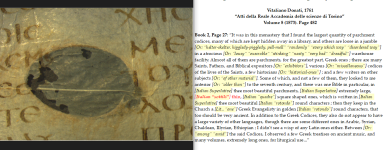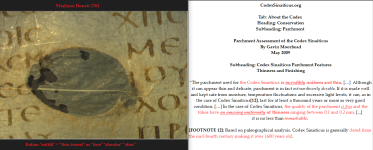You are using an out of date browser. It may not display this or other websites correctly.
You should upgrade or use an alternative browser.
You should upgrade or use an alternative browser.
Codex Sinaiticus and Constantine Simonides and Vitaliano Donati 1761
- Thread starter TwoNoteableCorruptions
- Start date
Steven Avery
Well-known member
because the MS. in question (as the librarian of our holy monastery, having been so from the year 1841 to 1858, assured me) belonged to the library of the monastery, and was marked in its ancient catalogue(s).
So why didn’t they produce this supposed catalog(s),
Would have been an easy way to end the controversy.
Simonides would have been really dumb to make a claim of MT. Athos production, if they had not made the manuscript and its antiquity could be demonstrated so quickly and easily.
TwoNoteableCorruptions
Well-known member
So why didn’t they produce this supposed catalog(s),
Would have been an easy way to end the controversy.
Simonides would have been really dumb to make a claim of MT. Athos production, if they had not made the manuscript and its antiquity could be demonstrated so quickly and easily.
No catalog ever existed...
Right?
TwoNoteableCorruptions
Well-known member
Simonides would have been really dumb to make a claim of MT. Athos production, if they had not made the manuscript and its antiquity could be demonstrated so quickly and easily.
Absolutely true...
But....
Simonide's had 19 years (from 1841 to 1860), to retrospectively gather all kinds of information from all kinds of sources (oral and/or written) about St Catherine's manuscripts etc etc etc, and wether there was a catalog or not that listed what we now call "the Codex Sinaiticus".
Or at least 16 years (from 1844 to 1860) to retrospectively gather all kinds of information from all kinds of sources (oral and/or written) about St Catherine's manuscripts etc etc etc, and wether there was a catalog or not that listed what we now call "the Codex Sinaiticus".
All, or even some of such intel (information) could have been (and actually was) supplied from friends acquaintances, benefactors, and even unwitting opponents.
- 19 year project
- 16 year project
And worst case scenario:
- 4 year project (plot of revenge)
The worst case scenario being 4 years (from 1856 to 1860) to retrospectively gather all kinds of information from all kinds of sources (oral and/or written) about St Catherine's manuscripts etc, and wether there was a catalog or not that listed what we now call "the Codex Sinaiticus".
Four years (at a minimum) is plenty of time to come up with a story... PLENTY...
And then distort all that information, all the retrospective/hindsight, after-fact resources that had become available over a decade or more, and distort it all into a plausible and deviously cunning story.
Last edited:
TwoNoteableCorruptions
Well-known member
NOTE: Any reference to the manuscript in a genuinely "ancient catalogue" written by any of the resident monks at St Catherine's would not have been listed or described by any modern names or titles, such as:
It's something to keep in mind.
- Codex Sinaiticus
- Codex Frederico-Augustanus, or
- Codex Simonideios
It's something to keep in mind.
Steven Avery
Well-known member
No catalog ever existed...
Right?
See my earlier post.
There should have been a catalog from 1734, by Nicephorus Marthalis Glykos.
If he mentioned a ms. matching Sinaiticus, it would have been a spectacular verification of antiquity, or at least from way before the Russico Ramblers.
Steven Avery
Well-known member
retrospectively gather all kinds of information from all kinds of sources (oral and/or written) about St Catherine's manuscripts etc ...
So is that how Simonides learned about the Tischendorf abstraction theft in 1844, from inside sources at St. Catherine's?
Steven Avery
Well-known member
When Simonides was working all his sources in St. Catherine's to plan ahead for his Sinaiticus claims, under your novel theory, checking to see what was in the St. Catherine's catalogues from afar, did Simonides also run over to Mount Athos and tamper with the Mt. Athos library catalog entries for the exact time of proposed preparation? That catalogue was published in 1895 and 1900 by Spyridon Lambros and showed Simonides, Kallinikos and Benedict working on manuscripts. (Including two entries that have Simonides and Kallinikos working consecutively copying the same ms.)
Did Simonides come out with his Hermas edition, years before the Sinaiticus "discovery" by Tischendorf and very similar to Sinaiticus and accused of being a Latin retro-version by Tischendorf, as part of this conspiratorial preparatory work?
Go, conspiracy, go!
Did Simonides come out with his Hermas edition, years before the Sinaiticus "discovery" by Tischendorf and very similar to Sinaiticus and accused of being a Latin retro-version by Tischendorf, as part of this conspiratorial preparatory work?
Go, conspiracy, go!
Last edited:
TwoNoteableCorruptions
Well-known member
See my earlier post.
There should have been a catalog from 1734, by Nicephorus Marthalis Glykos.
If he mentioned a ms. matching Sinaiticus, it would have been a spectacular verification of antiquity, or at least from way before the Russico Ramblers.
Not possible.
TwoNoteableCorruptions
Well-known member
So is that how Simonides learned about the Tischendorf abstraction theft in 1844, from inside sources at St. Catherine's?
1852...
TwoNoteableCorruptions
Well-known member
That catalogue was published in 1895 and 1900 by Spyridon Lambros and showed Simonides, Kallinikos and Benedict working on manuscripts. (Including two entries that have Simonides and Kallinikos working consecutively copying the same ms.)
What are the Athos manuscript numbers in the Lampros catalog?
Then we can check Kallinikos' Athos handwriting with the handwriting in his letters to Simonide's then...
Right...
Would be interesting to compare young Simonide's Unicial handwriting from Athos with the Sinaiticus then...
Sound good... Avery?
While we're at it, we can also check Benedict's Athos Unicial (or cursive) script with the Sinaiticus...
Whataya think...
I'd love to do it ?
But of course you've already done that Steven? You've personally gone back to the manuscripts and original handwriting at the Athos manuscripts website?
You've made every effort to email Mt Athos for permission to view online images of Benedict's, Simonide's, and Kallinikos'be manuscript handwriting from the numbers in the Lampros catalog for comparison to the Codex Sinaiticus, haven't you? Correct?
And we're waiting for you to publish your findings (any day now) for the entire world to see...
Steven?... Steven?
Last edited:
I'm sure he has no clue how to even use that catalog.What are the Athos manuscript numbers in the Lampros catalog?
Then we can check Kallinikos' Athos handwriting with the handwriting in his letters to Simonide's then...
Right...
Would be interesting to compare young Simonide's Unicial handwriting from Athos with the Sinaiticus then...
Sound good... Avery?
While we're at it, we can also check Benedict's Athos Unicial (or cursive) script with the Sinaiticus...
Whataya think...
I'd love to do it ?
But of course you've already done that Steven? You've personally gone back to the manuscripts and original handwriting at the Athos manuscripts website?
You've made every effort to email Mt Athos for permission to view online images of Benedict's, Simonide's, and Kallinikos'be manuscript handwriting from the numbers in the Lampros catalog for comparison to the Codex Sinaiticus, haven't you? Correct?
And we're waiting for you to publish your findings (any day now) for the entire world to see...
Steven?... Steven?
Steven Avery
Well-known member
1852...
The Tischendorf secret abstraction theft occurred in 1844, leading to his publishing the CFA, without indicating the source. And the theft was unknown to Uspensky in 1845 and 1850.
Specifically, why do your point to 1852?
TwoNoteableCorruptions
Well-known member
So what's specifically wrong, Mr Avery, with Vitaliano's use of Italian "rotondo" in 1761 to describe the Greek majuscule in the Codex Sinaiticus and the Golden Evangelistary, or MS, Sin. Gr. 204 (Lectionary 300, Greg. numbering)?
How specifically is Vitaliano's use of the Italian (a foreign language to you Mr Avery who only speaks English) word "rotondo" paleographically incorrect for his time?
How specifically is Vitaliano's use of the Italian (a foreign language to you Mr Avery who only speaks English) word "rotondo" paleographically incorrect for his time?
Steven Avery
Well-known member
So what's specifically wrong, Mr Avery, with Vitaliano's use of Italian "rotondo" in 1761 to describe the Greek majuscule in the Codex Sinaiticus and the Golden Evangelistary, or MS, Sin. Gr. 204 (Lectionary 300, Greg. numbering)?
How specifically is Vitaliano's use of the Italian (a foreign language to you Mr Avery who only speaks English) word "rotondo" paleographically incorrect for his time?
Where have you shown rotondo used for script that about a dozen writers call square?
TwoNoteableCorruptions
Well-known member
Where have you shown rotondo used for script that about a dozen writers call square?
You don't fool anyone by avoiding the specifics of the question.
Steven Avery
Well-known member
You don't fool anyone by avoiding the specifics of the question.
If rotondo is not commonly used for the boxy square script, you have what is “specifically wrong”.
TwoNoteableCorruptions
Well-known member
Where have you shown rotondo used for script that about a dozen writers call square?
So what's specifically wrong with Vitaliano's use of Italian "rotondo" in 1761 to describe the Greek majuscule in the Codex Sinaiticus?
How specifically is Vitaliano's use of the Italian word "rotondo" paleographically in-correct for his time?
Steven Avery
Well-known member
Repetition. See the previous post.
Remember, all sorts of travelers were in Sinai, none mentioned a “Sinaiticus” type manuscript.
Cyrillos said he learned of it only in 1841, after becoming librarian, according to Kallinikos the Absent.
So far, his catalogue, and all others, have no Sinaiticus reference.
Tischendorf said nobody knew of the manuscript till he found the leaves ready for burning.
A story he made up in 1859 to cover his 1844 theft.
The gang that couldn’t shoot straight.
Cover stories abound.
Look at the manuscript.
Remember, all sorts of travelers were in Sinai, none mentioned a “Sinaiticus” type manuscript.
Cyrillos said he learned of it only in 1841, after becoming librarian, according to Kallinikos the Absent.
So far, his catalogue, and all others, have no Sinaiticus reference.
Tischendorf said nobody knew of the manuscript till he found the leaves ready for burning.
A story he made up in 1859 to cover his 1844 theft.
The gang that couldn’t shoot straight.
Cover stories abound.
Look at the manuscript.
Last edited:
TwoNoteableCorruptions
Well-known member
If rotondo is not commonly used for the boxy square script, you have what is “specifically wrong”.
That's because you don't understand the historic development of paleographic terminology.
Because there was nothing wrong with using "rotondo" to describe the characteristically rounded letters in the Majuscule script of the Codex Sinaiticus in the 1700's.
Your judging Vitaliano anachronistically.
That's your mistake.


